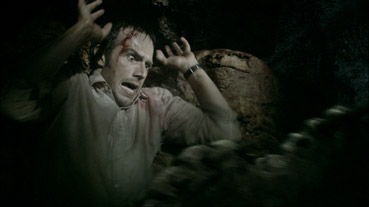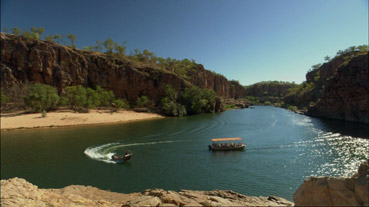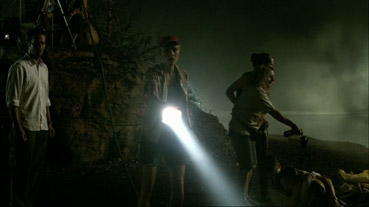| |
"I just saw a man get eaten by a fucking crocodile! This is not what I do, alright. You know what I do? I write stupid articles about hotels, restaurants, and resorts. Not about the Australian Outback. And by the way, I fucking
hate animals, especially ones that can kill you!" |
| |
Travel writer Pete McKell in Rogue |
The crocodile monster movie appears to be back in fashion. Actually, that's pushing it a bit, as I'm not sure that three movies really constitute a revival of something that never boasted enough films to be classed as a fashion anyway. But after a few years without a made-for-cinema croc movie, three come along at once: Michael Katleman's Primeval, David Nerlich and Andrew Traucki's Black Water, and Greg Mclean's Rogue. If, like me you were left groaning at the opportunities bungled by Mr. Katleman's opus, then take heart, as Black Water is better. Rogue is a lot better.
The set-up is standard genre stuff. American travel writer Pete McKell (Michael Vartan) arrives in a small outback post in the Australian Northern Territory to join a wildlife river cruise run by perky young boat owner Kate Ryan (Radha Mitchell). All is going well until the journey back, when one of the tourists sees what looks like a distress flare. Kate detours to investigate, and in the calm of a lagoon the boat is hit by a large crocodile and starts taking on water. They thus make haste to a small nearby island, where they find themselves trapped and threatened by a hungry and territorial reptile. And wouldn't you know it, their mobile phones are out of signal range and the radio has stopped working.

Nothing too revolutionary here, but within this framework there are some pleasant surprises. The visiting Americans (Pete's not the only one) are nicely underplayed, and the personalities of the passengers are quickly and believably established. Each of the well-chosen cast is given interesting bits of business for us to remember them by, from the husband and wife who argue about where to sit, to the man who quietly distributes his wife's ashes into the river, observed only by a young girl who then reacts warmly to her mother's presence. And though Peter and Kate are clearly being set up as the movie's hero and princess, we're into the last act before either of them come close to fulfilling these roles – that they then do so by the Joseph Campbell book is a bit of a shame, but I'll get to that in a minute.
Also poised to deal a surprise are Neil and Collin, two mouthy yobbos of the sort I like to think don't exist beyond the confines of Australian movies but probably do. Their timely return and show-off buffoonery may see them pay the predictable price, but once Neil (Sam Worthington) is trapped with the very tourists he previously mocked and insulted, it's he who becomes the resourceful and level-headed man of action, a role that initially seemed earmarked for Pete.
With the group effectively isolated from immediate help, the screws are tightened by the dual threat of rising tidal water and fading daylight, which promises to sink the island and do so in the black of night. There's more substantial land not too far away, but no-one's in a big hurry to jump in the lagoon and swim to get to it. Well almost no-one. In his new role as enterprising team leader, local boy Neil comes up with a plan that should be hairy enough to keep us chewing our fingernails for a good ten minutes, an opportunity fumbled by the group's inevitable and self-centered panic monkey.

It's in the last act that the freshness of the first two thirds slips a bit, as our Pete tumbles into the monster's lair – chasing after a doggie, no less – and gets to play St. George and rescue the fair maiden (hop to the next paragraph to avoid a spoiler on this). The CG croc is impressively rendered and seamlessly blended with the sets and animatronics, and the action itself should help you bite down any overlong nails. But the revelation that a character previously thought eaten has been kept alive for midnight snack feels like a cheat and undermines the boldness of dispatching them so unexpectedly in the first place. The specifics may be different, but we've been here a few too many times before.
But this does no serious harm to what is still a sprightly, well played and enjoyable old-school monster movie, one that builds engagingly to a traditional if well-handled climax via a genuinely tense midsection, in which the monster is for the most part kept hidden but remains an ever-present danger. Indeed, there's a commendable all-round restraint shown here that's likely to surprise anyone familiar with director Greg Mclean's punishing and disturbing debut feature Wolf Creek. Perhaps the biggest revelation of all is the Northern Territory itself, a majestic landscape of quite astonishing beauty, handsomely showcased by Will Gibson's crisp HD cinematography and offering an effective counterpoint to the natural horrors that lurk within.
Shot on 24p HD-CAM on the Sony HDW-F900 CineAlta camera – fast becoming a favourite with those shooting on HD rather than film – the image is consistently crisp in detail and rich in its tonal range and colour, with only a few burned out highlights (a waterfall in the opening aerial shots, a white shirt in the sunlight) giving away the film's digital origins. The contrast is spot on, with far better shadow detail than you might expect from the format and there are no obvious sign of compression artefacts.

A clear, well mixed 5.1 surround track that although front weighted for much of the film makes impressive use of the full sound stage when the action hots up, with some very distinct separation of effects in the climactic crocodile lair battle. Music is very nicely spread, and the lower frequencies are handled with subtlety.
Commentary by director Greg Mclean
A soft-spoken and very revealing commentary by director Mclean, who explains the project's genesis and then provides a wealth of information on the making of the film on a scene-by-scene basis, mixing technical details with anecdotes and his own happiness specific elements, which fortunately doesn't extend to a run of sentences starting with "I love this..." Of particular interest is the info provided on the scenes restored for the DVD cut of the film (all of which are so well integrated into their surroundings that it's hard to fathom why they were cut in the first place) and the use of digital effects for details you'd never have realised were touched up at all. The Jaws references are willingly acknowledged – it's one of Mclean's favourite films – and the director's deadpan humour provides its own share of entertainment: "Wolf Creek cost 1.5 million Australian dollars," he reveals, "which is about 6 dollars US," while the down side of filming outdoors, he assures us, is that "eels are going to bite your hand occasionally and attack you." It seems likely that this was recorded for the US DVD release, hence the references to American equivalents of some of the film's localised elements.
The Making of Rogue: A Documentary by Greg Mclean (46:08)
A comprehensive look at the making of the film built around interviews with key actors and crew personnel, and some fascinating behind-the-scenes footage. Documentary material from the 1970s helps illustrate the true story that inspired the script; Mclean talks about the actors and why they were chosen, and they in turn discuss their characters and experiences; the discomfort of working outside in 50 degree heat and on a sound stage in water are recalled; and almost every part of the film's production – including the score, the cinematography, the set construction, the make-up and the editing – are given a degree of coverage. The use of digital effects and animatronics are outlined in revealing detail, and particular effects are broken down to show how they were constructed. You're left with a strong sense of how drastically this technology has transformed the process of filmmaking, with everything from background scenery to the faces of stunt men (the face of the actor they are doubling can now be matted on) now open to post-production manipulation.

Welcome to the Territory contains three featurettes, all of which expand on areas covered in the documentary and recycle some of the footage included there.
The Effects (17:27) repeats some of the effects deconstruction from the documentary, but provides a lot more detail on the planning, the research, the rehearsals and the shooting of a number of scenes. It's all compelling stuff, and the full sized animatronic crocs are amazing.
The Music (14:40)
Composer François Tataz goes into intriguing detail about the composition of the score and illustration aplenty is provided by footage of its recording and some of the unorthodox instruments used. Tataz's frequent use of High Rising Terminal (a speech pattern that's become an Australian specialty in which statements are intoned in the manner of questions) may well irk those adverse to this particular twist of speech.
Northern Territory (14:39)
An appreciation of the beauty of Australia's Northern Territory, again built around cast and crew interviews and behind-the-scenes footage, plus a virtual repeat from elsewhere of information on crocodiles and the potential risks of filming so close to them. Capturing the aerial footage is also briefly covered.
The Real Rogue (2:30)
A brief pre-release podcast to provoke interest in the film in the manner of a traditional EPK.
Not as smart or inventive as the John Sayles scripted and Lewis Teague directed Alligator (1980), which remains for my money the king of this particular sub-genre, Rogue is still a slickly made and involving old-school monster movie whose well-defined characters, gorgeous locations, lurking monster and wind-up tension allow us to turn a blind eye to the more formulaic character arcs and narrative twists. Either way, Icon's disc really delivers, with a fine transfer and some excellent and substantial extras. For genre fans at least, this has to come recommended.
|